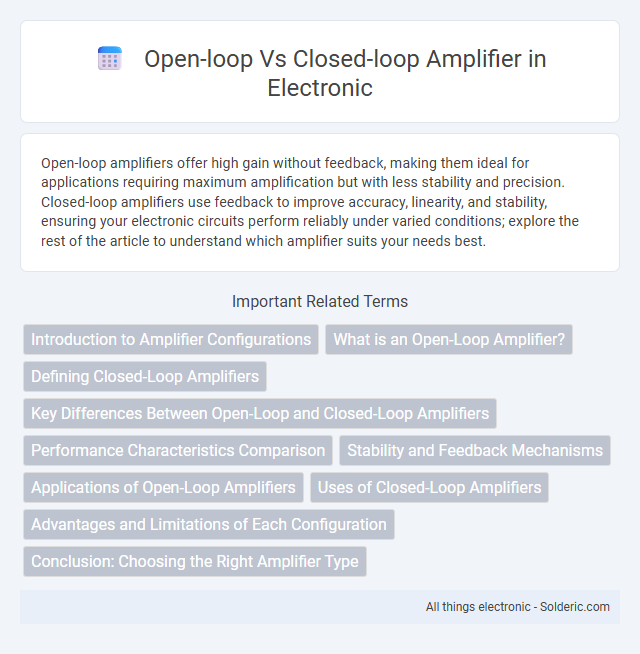Open-loop amplifiers offer high gain without feedback, making them ideal for applications requiring maximum amplification but with less stability and precision. Closed-loop amplifiers use feedback to improve accuracy, linearity, and stability, ensuring your electronic circuits perform reliably under varied conditions; explore the rest of the article to understand which amplifier suits your needs best.
Comparison Table
| Feature | Open-Loop Amplifier | Closed-Loop Amplifier |
|---|---|---|
| Gain | Very high, uncontrolled | Controlled, stable by feedback |
| Feedback | No feedback | Uses negative feedback |
| Stability | Low, prone to oscillations | High, improved stability |
| Distortion | High distortion | Low distortion |
| Bandwidth | Narrow | Wide bandwidth |
| Application | Test & measurement, internal circuits | Audio amplifiers, control systems |
Introduction to Amplifier Configurations
Open-loop amplifiers operate without feedback, offering high gain but limited control over output accuracy and stability, which makes them sensitive to component variations and environmental changes. Closed-loop amplifiers incorporate feedback networks that regulate gain and improve linearity, bandwidth, and distortion characteristics by comparing output signals to the input reference. Understanding these configurations is essential for optimizing amplifier performance in applications such as audio processing, signal conditioning, and control systems.
What is an Open-Loop Amplifier?
An open-loop amplifier is an electronic amplifier that operates without feedback, providing a very high gain determined solely by its internal components. This type of amplifier amplifies the input signal directly, making it highly sensitive but less stable and prone to distortion. Your choice of an open-loop amplifier is ideal for applications requiring maximum gain without the need for precise control or linearity.
Defining Closed-Loop Amplifiers
Closed-loop amplifiers incorporate feedback mechanisms that route a portion of the output signal back to the input, stabilizing gain and improving linearity. This feedback reduces distortion, controls bandwidth, and enhances overall amplifier performance compared to open-loop designs. Your choice of a closed-loop amplifier ensures precise gain control and consistent output in various electronic applications.
Key Differences Between Open-Loop and Closed-Loop Amplifiers
Open-loop amplifiers provide high gain without feedback, leading to greater distortion and limited bandwidth, whereas closed-loop amplifiers use feedback to stabilize gain, reduce distortion, and improve bandwidth. Closed-loop configurations offer predictable and consistent performance by controlling the overall gain, while open-loop amplifiers are more sensitive to variations in temperature and component values. The trade-off between gain accuracy and linearity is a primary consideration when choosing between open-loop and closed-loop amplifier designs.
Performance Characteristics Comparison
Open-loop amplifiers exhibit high gain but suffer from significant distortion and limited bandwidth, making them less stable in practical applications. Closed-loop amplifiers utilize feedback to enhance linearity, reduce distortion, and improve bandwidth, providing more stable and reliable performance. Your choice between open-loop and closed-loop configurations depends on the specific requirements for gain accuracy and signal fidelity in your circuit design.
Stability and Feedback Mechanisms
Closed-loop amplifiers offer enhanced stability by incorporating negative feedback mechanisms that reduce gain variations and distortion, ensuring consistent performance across varying operating conditions. Open-loop amplifiers lack feedback, which often results in higher gain but unstable operation prone to drift and nonlinearities. Your system benefits from closed-loop designs when precise and reliable amplification is crucial for maintaining signal integrity.
Applications of Open-Loop Amplifiers
Open-loop amplifiers are primarily used in applications requiring high gain without the need for precision or stability, such as in sensor signal conditioning, audio amplification, and basic analog circuits. Their simplicity and high amplification factor make them suitable for initial stages in feedback systems or as comparators in threshold detection. You can leverage open-loop amplifiers for rapid signal amplification where feedback control is not critical.
Uses of Closed-Loop Amplifiers
Closed-loop amplifiers are widely used in feedback control systems, audio equipment, and sensor signal conditioning to improve linearity and stability. By incorporating negative feedback, these amplifiers reduce distortion, minimize gain variations caused by temperature changes, and enhance bandwidth. Their ability to maintain consistent gain makes them essential in precision measurement instruments and communication devices.
Advantages and Limitations of Each Configuration
Open-loop amplifiers offer high gain and simplicity, making them ideal for applications requiring minimal signal processing but are limited by distortion and instability due to the absence of feedback. Closed-loop amplifiers provide improved linearity, reduced distortion, and enhanced bandwidth through feedback mechanisms, ensuring consistent performance but at the cost of reduced gain and increased design complexity. Your choice between these configurations depends on the specific requirements for gain, stability, and signal fidelity in your application.
Conclusion: Choosing the Right Amplifier Type
Selecting between an open-loop and closed-loop amplifier depends on your application's precision and stability requirements. Open-loop amplifiers offer high gain but lack feedback control, making them suitable for non-critical amplification where signal distortion is less concerning. Closed-loop amplifiers incorporate feedback mechanisms that enhance linearity and reduce distortion, providing reliable performance in sensitive signal processing tasks.
open-loop vs closed-loop amplifier Infographic

 solderic.com
solderic.com